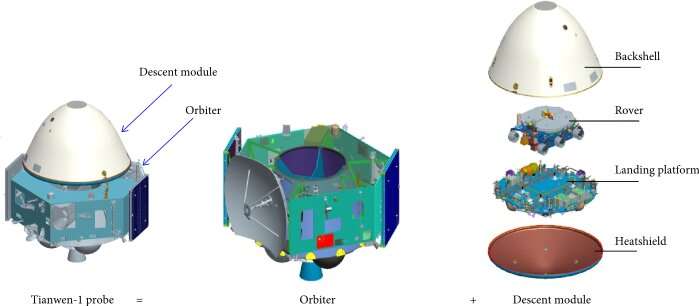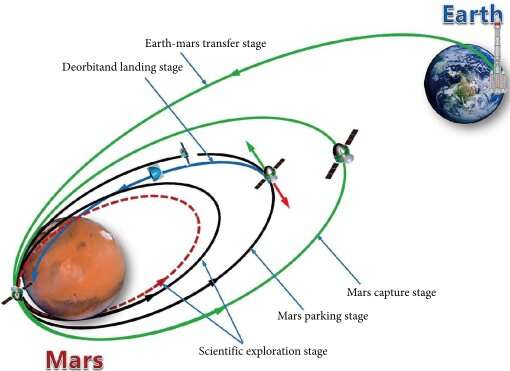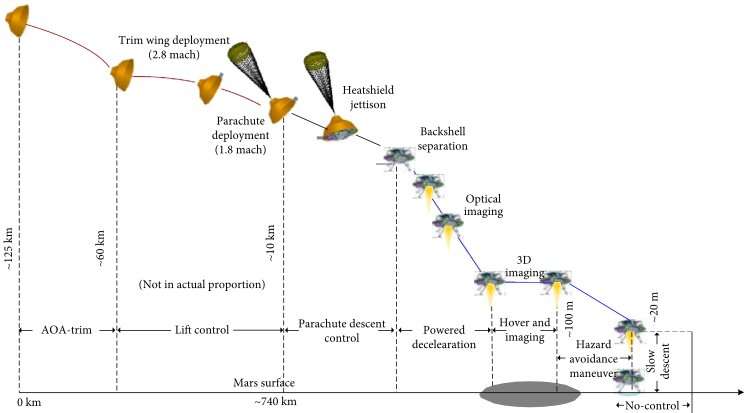Guiding Tianwen-1 to China's first successful Mars rover landing

Mars landing missions only succeed about half the time, a rate largely determined by the entry, descent and landing (EDL) phase, according to the researchers who designed Tianwen-1's control systems. They published their guidance, navigation and control approach for Tianwen-1 on October 16 in Space: Science & Technology.
"The EDL phase, which begins at the Mars atmosphere interface and ends with a surface touchdown, is crucial for a Mars landing mission," said Xiaolei Wang, researcher professor at Beijing Institute of Control Engineering.
Wang explained that most failures occur during this phase, typically because the communication delay between Mars and Earth is too large to accommodate the time urgency of the EDL phase.
"The spacecraft must perform autonomous guidance, navigation and control (GNC) to provide reliable key event triggers, as well as accurate and reliable state estimates to implement accurate and reliable trajectory and attitude controls," Wang said. "Any mistake may lead to a mission failure."
Multiple uncertainties, from the Mars environment to the complexity of the EDL process to the limited on-board computation abilities, further complicate the design of a suitable GNC system, according to first author Xianyu Huang, researcher professor at the Science and Technology on Space Intelligent Control Laboratory, Beijing Institute of Control Engineering.

"To meet these challenges, the GNC hardware should have a certain degree of redundancy, and the GNC algorithms should be suitable for on-board implementation, robust to sensors and actuator partial failures and adaptive to uncertainties," Huang said.
Tianwen-1 comprises an orbiter and a descent module, which includes a heatshield, a backshell and a lander with a landing platform and a rover. When moving from orbit to landing, the probe splits, with the descent module entering the Mars atmosphere, beginning the EDL process. Control during this phase requires that: all key events trigger correctly; no equipment collides as pieces separate; the lander selects a specific landing site within the pre-selected landing area; the lander's velocities, angular rate and other properties fall within required ranges; and that the process does not consume an unreasonable amount of fuel.
To fulfill the EDL requirements, the team built on previous GNC designs used for the third and fifth editions of Chang'E, China's lunar exploration spacecraft, as well as on control systems used in other successful Mars landing missions. Wang and Huang noted that the team also innovated new approaches, including an algorithm that more accurately interprets and predicts dynamic motion to balance the extreme swings of the initial parachute deployment to the steadier landing.
"The effectiveness of the GNC system design was demonstrated by the successful landing of Tianwen-1, which landed on Mars with a small landing eclipse, a soft touch-down velocity and a stable vertical attitude," Huang said.

The researchers noted that Tianwen-1 landed in a relatively flat area, but that future missions will target areas with more rugged terrain and potentially higher scientific value.
"This will put forward new requirements for the technology," Wang said. "The guidance, navigation and control system must have high-precision navigation and stronger maneuverability or deceleration capabilities."
More information: Xiangyu Huang et al, The Tianwen-1 Guidance, Navigation, and Control for Mars Entry, Descent, and Landing, Space: Science & Technology (2021). DOI: 10.34133/2021/9846185
Provided by Beijing Institute of Technology Press





















